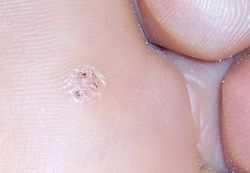Warts (Verruca Pedis)

What is a wart?
Warts are infections of the skin by the human papillomavirus. When the virus attacks the bottom of the foot it is called verruca plantaris (aka. plantar wart) and when it affects the foot in general it is called verruca pedis. Warts infect the outer layer of skin, the epidermis. A small opening in the skin will allow the wart to enter. Often the opening in the skin is small enough that it can’t be seen or felt. Warts are found predominately in moist environments. Showers, swimming pools, moist shoes, wet socks and floors are all common areas for warts to inhabit. Warts are also highly contagious. Once one person at home gets a wart, they are easily transferred to floors and showers for other family members to pick up.
Warts are typically felt as a sharp pain. They are rough and scaly, may have yellow and/ or pin-point dark spots, and interrupt the skin lines. The human papillomavirus interrupts the integrity of the skin and allows normally deeper blood vessels and nerves to become superficial so they can be seen and felt. They may be covered by callus, especially on the bottom of the foot, which makes them difficult to differentiate from corns or callus. Warts can appear anywhere on the foot.
Warts are often confused for other skin lesions, such as corns and callus. Therefore, it is important that a suspected wart be examined by a professional so that the condition is treated properly.
How can a Chiropodist help?
A Chiropodist can use a variety of chemicals to safely and effectively remove the skin containing the wart. They are also able to surgically excise (cut out) the wart, if necessary. Information about how to prevent re-infection of warts will also be discussed.
The information provided is intended for educational purposes only. It is not a substitute for a proper medical evaluation. Treatment options will vary from person to person.
Warts are infections of the skin by the human papillomavirus. When the virus attacks the bottom of the foot it is called verruca plantaris (aka. plantar wart) and when it affects the foot in general it is called verruca pedis. Warts infect the outer layer of skin, the epidermis. A small opening in the skin will allow the wart to enter. Often the opening in the skin is small enough that it can’t be seen or felt. Warts are found predominately in moist environments. Showers, swimming pools, moist shoes, wet socks and floors are all common areas for warts to inhabit. Warts are also highly contagious. Once one person at home gets a wart, they are easily transferred to floors and showers for other family members to pick up.
Warts are typically felt as a sharp pain. They are rough and scaly, may have yellow and/ or pin-point dark spots, and interrupt the skin lines. The human papillomavirus interrupts the integrity of the skin and allows normally deeper blood vessels and nerves to become superficial so they can be seen and felt. They may be covered by callus, especially on the bottom of the foot, which makes them difficult to differentiate from corns or callus. Warts can appear anywhere on the foot.
Warts are often confused for other skin lesions, such as corns and callus. Therefore, it is important that a suspected wart be examined by a professional so that the condition is treated properly.
How can a Chiropodist help?
A Chiropodist can use a variety of chemicals to safely and effectively remove the skin containing the wart. They are also able to surgically excise (cut out) the wart, if necessary. Information about how to prevent re-infection of warts will also be discussed.
The information provided is intended for educational purposes only. It is not a substitute for a proper medical evaluation. Treatment options will vary from person to person.
